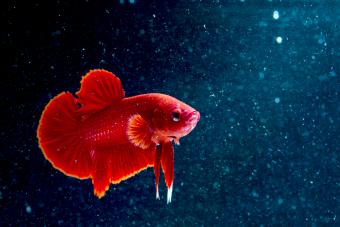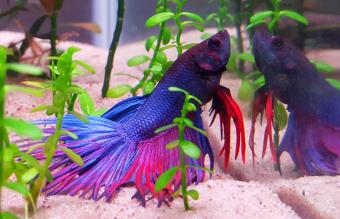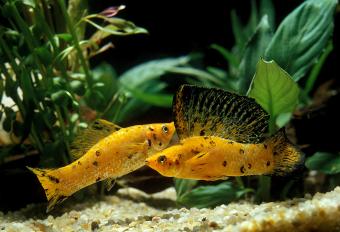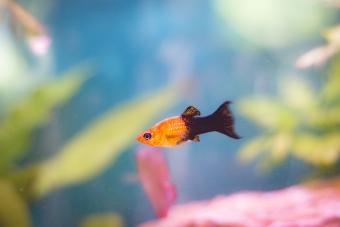
The Siamese fighting fish, Betta splendens, also known as the betta, is a vibrantly colored fish often seen swimming alone in ornamental vases or small aquariums. The betta has become the go-to starter fish, and it's not surprising considering their beautiful, distinct coloring. However, there's more to this species than the eye can see.
Different Species of Betta Fish
Contrary to popular belief, there isn't just one betta fish type. There are 73 species in the genus Betta native to Southeast Asia's Mekong Delta region, as well as a wide variety of B. splendens bred in captivity. The key to recognizing and classifying betta fish is to recognize that their huge range in appearance is due to the numerous colors, patterns, and tail types.
The colorful fancy bettas you'll typically see available in pet stores and online aquarium shops are all B. splendens. The chances you have this species is high, as this is the type most commonly available in the aquarium trade.
Betta Fish Care Guide
Bettas don't require a lot of space because they aren't extremely active or particularly large, which is part of their appeal to the average aquarist. Although they are known to be a "starter-fish," they do require more care to thrive than most are aware of. They can survive in a variety of conditions, but that doesn't mean they should have to live in an aquarium that isn't optimized for their care. Like all aquarium fish, bettas have care requirements, and you need to create the best environment possible for them to thrive.

Choosing the Aquarium for Proper Betta Care
Very small aquariums under 2.5 to 3 gallons in volume are not ideal for bettas. These are typically too small and do not meet the care requirements for the species. Bettas have the ability to breathe air and may thrive in oxygen-depleted settings with help from their labyrinth organ.
This apparatus allows them to breathe air to some extent. It also permits them to eat from the water's surface without fear of their swim bladder being disrupted, but they should not be placed in a small environment just because they can potentially survive in it. Water quality in small aquariums also tends to be more difficult to maintain than in larger aquarium setups.
A fish tank that's a minimum of 5 gallons is recommended. This tank volume allows bettas to engage in typical activity while also reducing the buildup of toxins in their environment. There is no such thing as too much swimming area, so if you are looking at tanks that are large, it's not a problem as long as it's wide and not overly deep. A deep tank is not suitable for bettas because they are used to swimming left-to-right in shallower waters, and a tank that is taller than it is wide limits their swimming area.
A rectangular tank is recommended as opposed to a traditional "fish bowl," or any tank that has a smaller surface area. Filter options tend to be restricted for these oddly shaped tanks, and reduced surface area limits oxygen exchange in the aquarium water.

Blackwater Aquariums
Setups designed to create a "blackwater" biotope -- which mimics the tannin-rich, soft, acidic water conditions of a betta's natural environment -- are very suitable for these fish, which live in slow-moving streams, puddles, and even rice paddies in the wild. The goal with such systems is to produce water that is slightly acidic -- slightly below 7 pH -- and soft -- meaning it has very little magnesium and calcium dissolved in it.
Adding certain types of leaf litter helps produce this effect. The idea is to the let the leaves slowly decompose in a controlled manner. As this happens, they release tannins into the water column. Indian almond leaves are particularly suitable for betta setups, but you must make sure to purchase these from a reputable vendor. Leaves that are treated with any chemicals, or that are not intended for use in aquariums, are not suitable for your betta setup. In effect, the leaves act as a natural water conditioner, producing an environment that is particularly suitable for bettas.
Indian almond leaves break down slowly, eventually decaying completely, at which point you can remove the remaining stems from the water and -- after performing necessary maintenance -- replace the leaves. You only need to add one or two leaves for every 2 gallons of water, depending on the size of the leaves. Test your water chemistry as the leaves begin to decay, making sure that you don't allow the water pH to drop too low. the ideal range is between 6.8 and 7, though bettas can tolerate pH between 6.5 and 7.5 quite well. As the leaves leech tannins into the water, it will become slightly brown, which is why these setups are called blackwater aquariums.
Floating plants, such as hornwart and duckweek, and those that enjoy lower light conditions, such as java fern and anubis species, do well in blackwater setups. Add driftwood and rocks, though be sure that the rocks you choose will not leach calcium or magnesium into the water. You can test a rock before adding it to the aquarium by pouring a small amount of white vinegar on its surface. If it bubbles up, the rock is not appropriate for your setup. Of course, the tinted aquarium water may obscure your view of your betta, but you can control the coloration with regular partial water changes, and many enjoy the natural look of a blackwater setup.

Add a Good Filtration System
To maintain water quality, bettas require a biological filtration system, preferably a low-flow type. The delicate fins of the fish must be protected from the suction of a filter. If your tank did not come with a filter, you can purchase one that best suits the aquarium you have chosen. Under gravel filters, hanging power filters, sponge filters, and internal filters are some examples of the types of systems available. Keep in mind, your betta should be able to swim freely without having to fight water flow from the filter.
Benefits of having a filtration system for your betta fish include:
- Reduction of toxins and waste: Mechanically removing excess food and fish waste, and breaking down ammonia and nitrite with beneficial bacteria.
- Oxygenation: Increases dissolved oxygen levels in the aquarium, which fish require to breathe.
- Tank mates: If you want any other fish in the aquarium, they will likely require higher dissolved oxygen levels than the betta.
- Maintenance: Reduced cleaning requirements and should maintain water quality balance over time.
Fish produce ammonia when they eliminate waste from their bodies. Ammonia is toxic to fish, and in a system with inadequate biological filtration, it can quickly build up and kill fish. When choosing the best filter for your individual aquarium, be certain to:
- Do your research and determine the best filter affordable to you -- many small setups come with adequate filtration for a single betta.
- Cycle your aquarium before adding fish, allowing at least a few weeks, up to a month, for biological filtration to begin working -- additives can speed this process up.
- Keep your filter running at all times (if you stop the filter, toxins and pollutants can build up quickly and oxygen will quickly be reduced).
- Remove and replace approximately 10 to 25 percent of the water weekly, regardless of tank size, and replace it with either reverse osmosis-treated water, or tap water that has been treated to neutralize chlorine and chloramines.

Add Gravel, Plants, and Accessories
One of the most exciting aspects about owning a betta is decorating their tank. Keep in mind, you don't want to overdecorate and eliminate their swimming room, but some decor in the tank is perfectly acceptable. Bettas aren't picky when it comes to aquarium décor, but they do enjoy being stimulated. They can be found hiding in, resting on, and constructing bubble nests at the surface around the decor in the aquarium.
Plants are also beneficial to your betta, particularly if they can swim in and out of them and hide in the foliage. Plants don't take up a lot of space in the aquarium and can give the aquarium a natural appearance. Live plants can also aid in the maintenance of a healthy and clean aquarium.
Remember that some decorations may have sharp edges or projecting elements that a betta could catch or damage their fins on. Some driftwood and pebbles may also have sharp edges, so inspect them carefully before placing them in the aquarium.

Aquarium Temperature for Betta Fish
Bettas are a tropical fish, which means they do best in warm waters. While they may appear to withstand cooler temperatures, they will become lethargic and more prone to disease, so keep the temperature between 75 and 80 degrees Fahrenheit to maintain their well-being. This can be accomplished with the use of an aquarium heater set to the right temperature. Make sure to study up on the heater you're considering to ensure that it can maintain a consistent temperature. Look for product reviews to be sure it's of good quality.

Water pH Level
Betta fish prefer a pH level of 7, but they can tolerate a range of 6.5 to 7. Higher pH values can cause negatively impact ammonia levels, which can quickly reach lethal levels; lower pH levels can damage your betta internally and externally.
Commercial products designed to raise or lower the pH, if necessary, to alter the pH of your fish's water are available at most pet stores. Water maintenance that is proactive is always the best option as opposed to adding product to the water. To keep water pH steady, be certain to keep up on your water changes and vacuum the gravel. The alkalinity (carbonate) in the water will be used by the biological filter bacteria that break down fish wastes over time, and the pH will gradually drop (become more acidic). This can be avoided by doing water changes to remove the lower pH water and replace it with fresh, dechlorinated water to stabilize the pH.

Feeding Betta Fish
Due to their carnivorous nature, they do require a significant amount of protein. There's a common misconception that bettas can thrive solely on plant-based material. It's important to ensure your betta has the proper diet to maintain their well-being.
Betta pellets, which are high in protein and are readily available in pet stores, should be the bulk of your betta fish's diet. It's critical to use a betta-specific pellet formula. Those made for tropical fish, for example, will not be healthy. Betta flakes and pellets contain the proper amount of protein and other vital nutrients for your betta fish.
If you want to give your betta something extra as a treat, you can offer brine shrimp and bloodworms. These will provide added protein and serve as a delicious treat for your fish. They should not be utilized as the sole component of your fish's diet and must be offered in moderation.

Healthy Versus Sick Betta Fish
You should be able to tell the difference between a healthy betta and one that is ill. This has an impact on the type of care you'll need to give them in the future, whether you're looking for one to purchase or you need to keep an eye on one you already have.
A healthy betta will:
- Swim freely
- Appear vibrant (especially males)
- Eat on a regular basis
- Possess healthy-looking fins
A sick betta will:
- Appear lethargic
- May hide the majority of the time; will not swim freely
- Appear dull in coloration
- Possess white growths on fins or body
- Lack of appetite
- Appear bloated

Can the Betta Have Tankmates?
Male bettas are extremely territorial, especially toward one another, and must be kept apart or in a container with partitions. They can be kept in a tranquil community aquarium of 15 gallons or more with other fish. Tetras, placid barbs, rasboras, livebearers, Corydoras catfish, and a variety of other non-aggressive, low-activity fish are all good tankmates. Male gouramis, fin-nippers, such as tiger barbs, and aggressive fish, such as gigantic danios, should all be avoided.

Enjoying Your Betta Fish
While there is a lot to know about proper care and keeping of betta fish, once you've spent some time learning, you'll realize why they're such popular fish. Aside from their lovely coloring and fins, they're easy to care for once you have a proper tank set up and they're intelligent fish with definite personalities that set them apart from other types of pet fish.







